
|

|

|

|

|

|

|

|

|

|

|

|

|

|

|

|

|

|
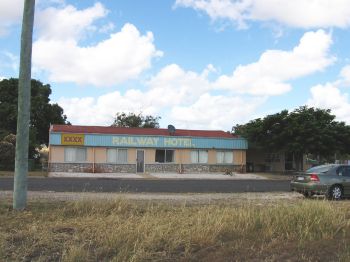
|
|
Almost by accident we stumbled on the old mining town of Marmor, right on the main highway some 30-40 kilometers south of Rockhampton. All that's really visible from the highway is the BP Roadhouse, but turn onto the way less travelled....
Established in the late 1800s as a mining settlement and obviously once MUCH bigger than it is today, Marmor today typifies that knife edge that so many small rural towns balance on. Look around, at first sight it's pretty desolate but dig a bit deeper and this is a viable small town despite appearances. Hey, it has a pub! The limestone mine is still functioning as a small operation. There's a School, Police Station and Church. Even a picnic table, playground, war memorial and Pioneers' Cemetary.
Suddenly you also notice that a lot of the houses have a small aluminium boat in the yard... Oh, the turn off to Port Alma is just a couple of kilometres north. I get it.... cheap land and houses, basic infrastructure available (probably not broadband internet but not sure), the large town of Rockhampton just to the north, boating and fishing. Not for me but hey, each to his own.
Thanks to Ken from Canberra who has provided some great historical anecdotes about Rockhampton and Marmor.
Update 6 April 2008
Thanks also to Aaron who grew up at nearby Bajool. He tells us that the "recycled" church (see below) closed in the late 1980's as he recalls, that it was then used as an Arts & Crafts outlet for a while and is now a residence.
Update 5 June 2012
Thanks also to John McCartney for sharing some of his web research with us and thus solving the questions
I posed regarding the small church with the skewed crosses:
I see you have a great photo of a church in Marmor Queensland. You were wondering what the name is - I believe
it is (or used to be) St Faith's Anglican church. Not sure how the crosses came to be askew though - maybe when it
was "secularised" - see below
One web citation -
St Faith's Marmor.
After consultations over a period of time with those associated with St Faith's Marmor, I formally secularised and closed
St Faith's at a special Thanksgiving service in March this year. It is some years since this little church had been used for worship.
Presidential Address
The Right Reverend Godfrey Fryar
11th Bishop of Rockhampton
136th SYNOD
13-15 May 2011
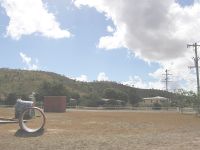
Looking roughly SE from the playground across part of Marmor. There's limestone in them there hills! |
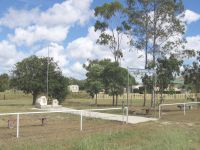
The memorial honouring those WW2 veterans from Marmor and surrounds who served. I wonder if any still live in the town or nearby? |
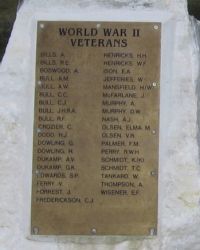
This is the list of veterans from Marmor at the War Memorial. Check out the list of names; two Schmidts served and may have even fought against the Germans. How crazy is war. |
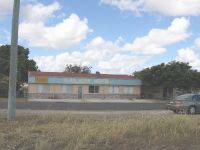
The Railway Hotel in Marmor. Any town that still has a pub still has a future! I wonder what magnificent old pubs graced Marmor in its heyday? |
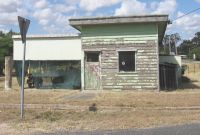
The former Marmor Butcher Shop, now used as a storage area/workshop. You can still see the shop title in the peeling paint. Also see the concrete kerb and guttering and a "Give Way" sign; more clues to a grander past? |
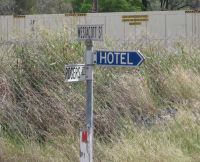
The street sign opposite the old Marmor Butcher Shop, and it seems to be quite a recent addition. Could a Marmor resurgence be imminient? |
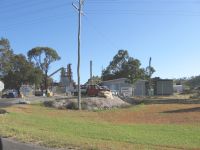
The Unimin Limestone facility at Marmor is still in operation. See the Unimin web site for operational details. |
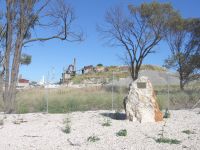
View of the Marmor Pioneers' Cemetary site with the Unimin facility in the background. |
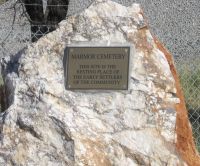
The plaque marking the site of the early Marmor settlers' graves. Obviously the names and exact grave placement has been lost over the years. A nice touch to use a pillar of the local limestone as the marker for the site. |
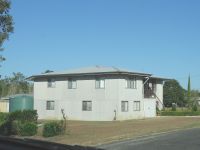
A typical Marmor residence, this time of fibro construction. Note the wall discolouration, probably from mineral-laden bore water and the neat hedge. |
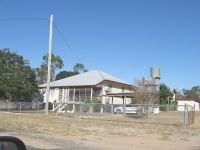
The Police Station for Marmor (and the surrounding area I presume). |
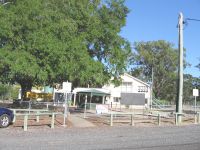
The Marmor State School celebrated its 100th birthday in 2006. |
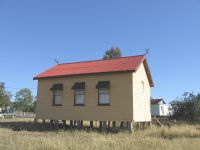
The only operational church I could find in Marmor. There is no name, so I guess it is a "generic" church used on a rotational basis by the various congregations. I wonder how the crosses on the roof came to be askew? Question answered please see above, thanks to John McCartney :) |
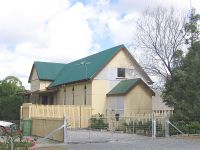
A former Catholic church (thanks Aaron) next to the playground in Marmor, now in use as a private residence, after an earlier incarnation as an Arts & Crafts shop. |
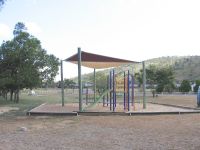
The playground, taken from the picnic table and shelter where the exploration of Marmor began!. The War Memorial is in the background. |
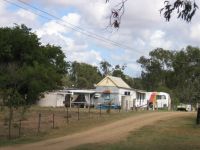
A small house with some inventive "extensions" near the playground in Marmor. |

|

|
|
|
|